Introduction
The process of Developing Individual Teams and Organizations will be analysed in this report with a personal skill development plan. Human resource management is the department which controls the employees in an organization (Barlow et al., 2012). The responsibilities of the department are to attract, select, appoint and develop employees for the betterment of the organization. HR professionals execute all the work for their organization, and they should be hard-working, proactive and sincere. HR people follow professionals as their models therefore, professionals should have the quality of being models. Knowledge, skills and behaviours of professionals will influence employees to give their best performance which helps an organization achieve its targeted success (Bastian et al., 2012). Tesco is a British multinational retailer company which has been selected in this business report to analyse different approaches of performance with examples.
You may also feel interested to read below blogs:
Strategic Human Resource Management at Audley
Tourism strategies for Broadstairs coastal area
International Marketing Strategies of MNCs
Research Proposal on Vodafone’s decreasing share in India
Importance of HRM Practices to Business Strategies
Organizational learning is the way of learning in which employees learn by doing work and innovating for their organizational betterment (Georgopoulos et al., 2010). This learning helps employees to execute the works of their organization smoothly and achieve success for the organization. On the other side, individual learning is the way of learning in which employees learn by the method they will be able to learn properly (Bastian, Jetten, and Radke, 2012). Individual learning and development are arranged by employees, and organizational learning and training approach get arranged by the organization. Both of the learning enhance the ability of employees.
Individual Learning
Firstly, Employees arrange individual learning to increase their knowledge and capacity. Through this learning, employees can prevent their weaknesses and become able to improve their performance (Subramony, 2009). It improves an employee’s personal ability to do work and they can contribute outstanding performance on Tesco.
Secondly, Individual employee arranges individual learning for personal development therefore, it does not need many expenses (Jhong, Brushett, and Kenis, 2013).
Thirdly, Individual learning brings improvement in an employee’s ability. Employees become able to improve their performance and make their place by giving outstanding performance in the organization (Engdahl et al., 2010). It makes their performance better in Tesco.
Finally, through individual learning, employees learn what they want to learn and hold their improvement as long as they want to (Verma et al., 2016). The sustainability of individual learning does not exist for a long time because they stop learning when they wish.
Organizational Learning
Firstly, organizations arrange organizational training and learning to enhance employees’ abilities for their own betterment (Van den Heijkant et al., 2015). When employees become more eligible, it brings better output for Tesco therefore company arrange training to make employees more capable of doing work.
Secondly, Organizational training is arranged by the company and they train many employees together therefore it consumes much time to arrange the training (Moeinifar, Kokabi, and Hosseini, 2010). They train every employee who needs training and it is an expensive program. Gathering employees and arranging training and arrangements needs money from the organization.
Thirdly, organizational training develops every employee’s ability and it will help Tesco to maintain its world class level. It brings an outstanding result for the company and they may become more successful.
Finally, organizational training lasts long because it makes employees disciplined (Dumas, Benatallah, and Nezhad, 2008). Employees repeat their learning with their everyday work therefore it lasts long. Tesco arranges organizational training to make the learning of employees sustainable and long-term betterment of them.
Differences between training and development:
Training is a way of giving lessons on a specific skill and knowledge (Cohen, 2017). Training is beneficial to utilize employees’ contribution to their organization. They become capable to give better performance after having training on the issue that needs improvement. Development is the process of bringing positivity and progress to an employee (Aguinis, and Kraiger, 2009). It brings positive change within people for the betterment of their careers and organization.
Training and development both improve the capability of employees which helps them to give outstanding performance. There are many differences between training and development and these differences are analysed underneath:
Training:
Firstly, training is arranged to make employees capable of facing the recent challenges of a company. The influence of training lasts for a short time because it teaches employees for only 1day, 1 week and 1 or more months (Salas et al., 2012). Employees can improve their communication skills through training and it ensures better performance of them.
Secondly, training is designed for a particular job position (Moser, 2012). Employees can perform their duties effectively therefore it does not influence much in an employee’s personal life. A company become able to achieve its goal by train up employees on the skills that will be beneficial for the job.
Thirdly, the target of training is improving employees’ capability on a certain skill which is needed in the company to continue their job such as: teaching how to use a database. The concept of training is narrow (Kozlowski, and Salas, 2009).
Fourthly, experts or tutor teaches employees in the process of training. Company train employees who are new in the company and specific departments of the group (Blume et al., 2010). Employees follow the guideline of tutors or experts to learn new things which increases their knowledge.
Development:
Firstly, the influence of development lasts long because it emphasizes long-term improvement (Hyde et al., 2009). It is planned for numerous months or years to continue the development process of employees. HRM uses different strategies to bring development within employees and it helps to hold on long term success.
Secondly, it focuses on an employee, not on their job post (Van Vianen, Dalhoeven, and De Pater, 2011). Development finds the best within employees and in which sector they will do better easily. It helps employees to build their professional careers successfully.
Thirdly, development is a broader concept which develops the skills and knowledge of employees. It indicates altering practices, developing skills, and philosophical issues and all these will help employees to cope with the new requirements of different companies (Costen, and Salazar, 2011).
Fourthly, it is a process which emphasizes self-learning (Jehanzeb, and Bashir, 2013). Employees do not learn by following any tutor because they go through self-learning and bring progress to their career following the strategies put on by the HRM manager.
Importance of continuous learning and professional development to maintain the quality of performance:
To maintain outstanding performance, employees have to continue their own development and learning (Manne et al., 2012). Continuous learning and development bring success to an organization. A continuous learning process has been analysed through a learning cycle is described below:
Kolb’s learning cycle has been selected to analyse the need for continuous learning and professional development. This cycle has four steps which are described below:
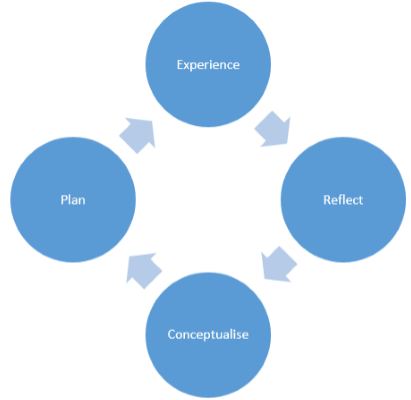
Importance of continuous learning and professional development for employees:
Keep updating: The business world has become very much competitive therefore learning and professional development are needed to keep businesses updated (Moeinifar, Kokabi, and Hosseini, 2011). The requirement of the job and style of work changes every day. Continuous learning and professional development help them to stay modernised and make their company more advanced. It is the first segment of Kolb’s learning cycle in which employees can be updated with acquired experience (Brito, Bastos, and Costa, 2012). Employees of Tesco should gain experience by involving more in their work.
Increasing positivity: When employees continue their learning and professional development, it increases their confidence of employees (Nofar, Hosseini, and Kolagar-Daroonkolaie, 2009). They become more confident than before and try to solve different kinds of problems. Learning also increases the sense of cooperation among employees through which they work collaboratively for Tesco. Reflection is the second segment of the cycle and it helps employees to monitor what have they done and it grows their confidence level of employees (Van De Voorde, Paauwe, and Van Veldhoven, 2012). Confident employees are able to bring outstanding outcomes for Tesco.
Facing challenges: Employees can learn how to handle complex situations through continuous learning and development (Naghibi, Sani, and Hosseini, 2014). It keeps employees ready to handle any situation and it will help Tesco to prevent all kinds of risks. This situation is part of conceptualization in which employees become able to face challenges (Iles, Chuai, and Preece, 2010).
Importance of continuous learning and professional development for employers:
Invention and creativity: An organization can bring invention and creativity to their organisation with the continuous learning of their employees (Snape, and Redman, 2010). Employees find a new way of making their company strong than their competitors. The last segment of the learning cycle is a plan which involves invention and creativity (Renee Baptiste, 2008).
Training and development keep the employees updated, and they can perform better than other people in different organizations. Therefore, it is worth it for a company to invest in employee training and development.
Training and development create the mentality of the employees in such a way that they can accept any challenges and can execute tough jobs because they have the ability. Such an attitude helps the company to execute projects in convenient ways.
Training and development play a great role in enhancing the capabilities of employees by preventing their weaknesses. When an organization arranges training and development it motivates employees greatly because they get the chance to improve their skills and do their work in a better way.
Training and development help employees do their work efficiently than before. They can utilize the learning that they have learned from training and development. It plays a role in making their career better and makes employees loyal to their organization. Training and development help to increase employee retention.
Definition of High Performance Work (HPW)
High-performance work is an atmosphere of a company in which employees can give their best performance (Akhtar, Ding, and Ge, 2008). In this work environment, employees can maintain the quality of their work. Employee engagement is the way in which employees stay proactive in doing their job and fulfilling their obligation toward their organization (Moeinifar, Kokabi, and Hosseini, 2011). Engaged employees work effectively to achieve the corporate objectives of their organization.
In this process a company can produce products and services at low cost with the same value as their competitors, it is called competitive advantage (Erbes, Nezhad, and Graupner, 2012).
Elements of High-Performance Work (HPW)
The elements of HPW are outlined below:
- People
- Structure
- Technology
- Reward systems
- Job design
How to activate High-Performance Work (HPW)
From the scenario of Tesco, some strategies have been identified to establish to ensure a high-performance work environment. These strategies are analysed below:
By guiding people in the right way HPW can be activated because it will help people to understand their work well (Chandra, 2016). Tesco guides their employee in the right way and it motivates them to give their best.
An organization should make a clear structure therefore employees can understand the structure easily (Devece, Palacios-Marqués and Alguacil, 2016). When they understand the structure they can plan their own work and understand responsibilities and it actives HPW in Tesco.
Using technology within an organization reduces manual work, and employees can use it to establish better communication (Lamb and Kwok, 2016). Advanced and updated technology helps employees to do flawless work in Tesco, such as: preparing customers’ bills through software activating HPW.
Reward systems motivate employees to give outstanding performance by using their capabilities. It is one of the most effective ways to activate HPW in Tesco and any other organization.
The job should be designed by evaluating the capabilities of employees. Tesco will find out which employees fit in which sector. It will bring a better outcomes for an organization because employees get the responsibilities of that sector in which they are good.
Employees of Tesco work collaboratively, and collaboration is a way to high performing working environment. They help each other in doing their work, and it ensures high-performance work environment within the company.
A team meeting is a method of a high-performing working environment, and it is an effective process for increasing employee engagement. Employees of an organization can seat together and plan their work by discussing it with each other (Thompson, 2011). Tesco will be able to save time in the decision-making process. Employees can take important decisions easily through a team meeting.
The off-site meeting is the other effective way of making decisions and this is also a medium of the HPW environment (Yang, and Lin, 2009). Tesco will arrange the meeting to ensure that everyone gets a chance to meet one another. This meeting helps to communicate with the president and other members of an organization. It saves employees time because they can communicate with the president and other members in one place. It also ensures employee engagement.
Outcomes of High Performance Work (HPW)
Collaboration helps employees to make their work easy by helping each other (Alfes et al., 2013). In addition, it creates strong relationships among employees and ensures employee engagement in Tesco.
When employees of an organization work in order to achieve the same vision and mission, this approach helps an organization to increase employee engagement (Keshavarz et al., 2009). Tesco motivates its employees to work with the same vision and vision. It drives the success of the company by directing them toward achieving its goal. Employees will be able to provide the best service for the customers by following the vision of Tesco to maintain its success globally.
Because of HPW, it will make the decision-making process short and team members get the chance to express their opinion in the meeting. This will make the employees happy at Tesco, and employees will give their best to maintain the global position of Tesco.
Employee engagement increases when HPW occurs. When employee engagement increases, the operational cost decreases automatically and Tesco will become more profitable.
In HPW, the employees give their best, and it ensures the best service will be provided to the customers (Buchanan and McCalman, 2018). When customers will get best service from Tesco, it will increase customer satisfaction. Customers will maintain repeatable sales, and the demand for Tesco will increase.
HPW helps to make an organization’s service better than its competitors (Noe et al., 2017). Tesco will be able to make its service unique from competitors by establishing a work environment. It will help to achieve a strong competitive advantage, and the position of Tesco will be stronger in the global market.
Definition of Performance Management
Performance management is a complete system which starts with making a job position and creating the required qualification and it ends when the employee leaves the organization (Alfes et al., 2013). All the steps, and approaches in between are together called performance management.
Approaches to Performance Management
An organization can use different approaches to PM. It depends on the type of organization and its needs. In the below section, different approaches to PM have been analysed, and the most suitable approach for Tesco is selected.
Comparative Approach: This approach compares the performance of every employee with that of other employees (Paauwe, 2009). For example, it ranks employees based on different categories such as top performances, good performances, average performers and finally, bad performers. The advantage of this approach is that management can clearly understand who top performers are, and it becomes easy to decide whom to promote to upper management decision. Problem with this approach is that there is no clear description based on what the employees should be ranked.
Attribute Approach: This approach considers a number of skills while evaluating the performance of an employee (Subramony, 2009). These skills are listed below:
1. Problem-solving skills
2. Teamwork and communication
3. Judgement, creativity and innovation
The advantage of this approach is that it considers a wide range of issues and considers all of them to evaluate an employee. Moreover, the listed issues are of high importance for any organization.
The disadvantage of the approach is that free thinking can be discouraged by this performance management system. The skills of creativity might be ignored, which can bring an outstanding outcome.
Behavioural Approach: This approach considers a series of dimensions related to a job, and then it marks the dimensions in discussion with the employees (Snape and Redman, 2010). The advantage of this approach is that it conducts discussions with employees and thus it is inclusive. The problem with this approach is that the evaluation may be affected by the influences of the employees.
Result Approach: This approach evaluates the performance of employees considering the financial outcome, customer feedback and support, internal operations, learning and growth capability of the employees (Shaw et al., 2009). This approach helps the management to make a fair judgements of the employees because they can consider a wide range of issues. Problem is that it has less focus on human resource aspects of the organization.
Quality Approach: This approach is based on the motive of reducing errors and improving quality perspective through continuous development. It is helpful for organizations because it gives regular feedback to the management about the difficulties employee face, and strategies to solve the problems.
Among all the approaches, the attribute approach would be the most suitable one for Tesco because this approach considers a range of issues while evaluating the performance of employees. Moreover, this approach will help the company to strengthen the efforts of the employees because a wide range of topics is considered.
Recommendations:
a) Tesco should find out the weakness of their employees and arrange training and develop plans to enhance their abilities. Employees’ improvement will bring outstanding outcomes for the company.
b) HR professionals of Tesco should have the skill of selecting an appropriate employee for the company. They have to find out the right employee among so many candidates because the wrong employees will create problems in the workplace.
c) Tesco should gather reviews from everyone and inform everyone about their fault which will make scope to prevent mistakes in future work. It also helps to maintain the quality of performance.
e) Tesco should make proper use of advanced technology to stay connected with its customers and related parties globally. It will help them to communicate with stakeholders easily, and promote their business through social sites.
The skills, knowledge and behaviour HR professionals should have:
The people who provide advice and services with expertise and accepted standards of behaviour about human resources are HR professionals. They use their expertise and knowledge to find out employees’ strengths and make an effective plan to utilize them. Weaknesses of employees are found by HR professionals to arrange training and development plans which will prevent the weakness. HR professionals play an outstanding role in an organization because they ensure the best output from employees to make their company profitable.
Employees work to achieve the goal of a company, and the success of a company depends on their employees (Salehi-Khojin et al., 2013). Employees should be eligible to execute all the work for their company and communicate successfully with all the stakeholders. It will help a company to keep its stakeholders happy, and it will increase its reputation also. HR professionals have to make their employees capable of making the company beneficial. They must have some skills and knowledge by which they become able to fulfil their responsibilities. These are analysed below
Understanding HR: One of the key responsibilities of HR professionals is that they have to find out the employees who will be perfect for the available post therefore, they must have knowledge of HR (Kyrieleis et al., 2009). A lot of people respond to a job circular, and most of the candidates are not eligible and worth the job. When professionals have the knowledge of understanding employees’ capabilities. For example, it helps them to select the perfect candidate for their organization who is worth being there. Wrong employee selection can harm a company’s flow of success by performing badly.
The skill of Communicating: HR professionals bring the outstanding output from the employees. They have to communicate with employees and other stakeholders regularly; therefore, they must have the skill to communicate effectively with employees (Chianeh, Hosseini, and Nofar, 2009). Good communication can make good relations, and a company’s success depends on a good relationship with its stakeholders. The communication skills of professionals will help a company to convince employees to bring a good outcome. They should be experts in both verbal and written communication therefore they will be able to communicate in the appropriate way that will be beneficial for them. The presentation skill of professionals will be effective for a company in many ways. For example, professionals are able to represent the company to internal and external stakeholders through the good presentation.
Curiosity for Learning: In this competitive era, the business world is getting complicated and updated. Professionals have to cope-up with the competitive business world, and their curiosity about learning will help them to learn the significant factors (Masoudi et al., 2012). Professionals help their companies to cope with the dynamic business world through outstanding performance through continuous learning. If professionals do not have the curiosity of learning, it will make the company weak in front of their competitors because professionals will be unaware of the factors they should update.
The skill of Working Collaboratively: HR professionals must have to work collaboratively with employees, and this skill will raise the sense of collaboration among employees (Lim et al., 2008). When professionals work collaboratively, it makes the company more profitable because operational costs are reduced when everybody works collaboratively for the well-being of their company.
Proper Managing skills: One of the important work of HR professionals is managing employees (Noe et al., 2017). They have to develop employees’ capability to bring better outcomes, make work breakdown of employees to make their work easy and take so many important decisions. Proper managing skills of professionals help them to take the right decisions and find a proper solutions to problems. The managing skill also helps to maintain discipline in the workplace.
The skill of Motivating: Employees work to achieve the goal of an organization. HR professionals have to motivate their employees which will make employees proactive and satisfied (Brushett et al., 2010). Satisfied and proactive employees give their best to their organization. If professionals motivate the employees, it will create employee satisfaction therefore employee retention will increase. When employee retention increases, their performance will be improved, and the company become able to achieve its target easily.
Handling Complex Situations: Every company has to go through many difficulties, and HR professionals should have the skills to solve problems (Paauwe, 2009). If they do not have the skill, problems can be complex Professionals have to know how to handle the complex situation. It will help to overcome the crisis, which may hamper the business.
Personal Skills Audit Analysis
To analyse the needed skills and behaviours, and knowledge, a completed personal skills audit is given below:
Name: George Harry
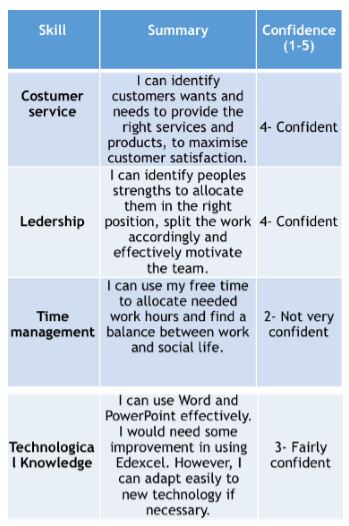
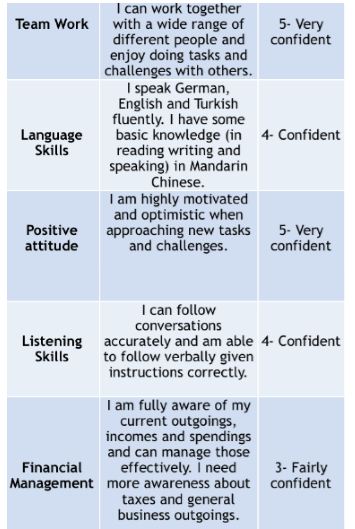
Findings of the personal skill audit are analysed below:
A table of individual personal skills audit and ranking of them:
| Name of skills | Rank 1 | Rank 2 | Rank 3 | Rank 4 | Rank 5 |
| Customer service | √ | s | |||
| Leadership | √ | ||||
| Time management | √ | ||||
| Technology knowledge | √ | ||||
| Team work | √ | ||||
| Language skills | √ | ||||
| Positive attitude | √ | ||||
| Listening skills | √ | ||||
| Financial Management | √ |
Meaning of the Rating:
1-Outstanding
2-Better
3-Good
4-Neutral
5-Bad
Customer service: From the personal skills of George Harry, it is seen that he is very confident that he can provide better customer service. He claims that he can identify the wants of his customer, which will help his company to identify customers’ demands. By identifying customers’ demands he will be able to create customer satisfaction, and it will bring more profit for his company.
Leadership: He is also confident about his leadership skills. He can identify the strengths of people, which will help him to utilize the power of employees. Ensuring the utilization of employees’ strengths he can allocate employees to the right position, and it ensures the best outcome for employees. He can motivate employees effectively, and it is one of the key required skills of HR professionals. Motivated employees stay loyal to their company and work hard to achieve the goal of their organization.
Time management: Time management means complete own work within a specific time. George is not confident about his time management skill because he is unable to complete his work within work hours and takes extra time to manage. He takes extra time to balance his work. He has to learn how to manage time otherwise he will not be able to handle work when the time will be short.
Technology knowledge: In this advanced era, technology plays an important role within an organization. George can use Word and PowerPoint which will help him to make a business report and effective presentation for meetings or training. Making effective business reports and presentations will help him to represent his company in front of stakeholders. But he is weak in using Excel, and it is a negative point for him. Excel will help him to store a large number of data easily. Therefore, he should learn to use Excel.
Teamwork: Teamwork is one of the most important skills of HR professionals. George is too much confident in his skills of teamwork. He has the ability to work with a different types of people, and it helps him to execute his tasks properly. These skills will help him to maintain discipline in the workplace by adjusting to everyone.
Language skills: In the skills audit it is seen that he can speak German, English and Turkish. English is an international language therefore, it will help him to communicate with people globally for the betterment of his company. German and Turkish languages will help him to communicate with the people of Germany and Turkey. It will help his company to make a better relationship with the local companies of these countries.
Positive Attitude: George has a positive mind, and positive-minded people can give better performance than others. He is highly motivated and optimistic which helps him to accept challenges in his work and finish his tasks successfully. He is not scared of risks and accepts challenges which will bring outstanding results for his company. His positivity will inspire other employees and his team member, and they will also try to be positive-minded.
Listening skills: Listening skills are also important which is required by every company. Listening skills help people to find out important information and notes from other’s briefings or lectures. George will be able to follow the verbal instructions of his seniors effectively, which will help him to execute his work by remembering the verbal instructions.
Financial management: George is aware of his income and spending. It will help him to monitor the budget of his company. He will be able to ensure the payment of tax. But he is not fairly confident about these skills therefore he should be more aware of the skills.
Personal SWOT analysis
| Strength | Weakness |
| From the completed skills audit, it is found that George Harry is very confident about his customers’ service. He analyses customers’ demand and behaves well, which help him to make them happy by fulfilling their demand. He claims that he can lead people well because he is able to identify their strengths to utilize them effectively. He is better at leadership which helps him to lead employees. He has expertise in teamwork and therefore can work collaboratively and is fully confident about that. He can speak German, English and Turkish, which will help him to collaborate with people of these countries. He has a very positive attitude and can face any kind of challenge. He has the patience to be an active listener, and it helps him to note important information from his superiors. | He is bad at finishing work on time because he never tries to do work punctually. He never tries to work on excel therefore, he is weak in technological knowledge. He is weak in the skill of managing financial activities. As a result, he cannot manage those activities. |
| Opportunities | Threats |
| He is very polite, disciplined and cooperative therefore, he can adjust to the team easily and is able to face challenges. He is fairly confident in his technological knowledge because he needs to learn more about using excel to store important data. His language skills is good in English, German and Turkish because he practices these languages, which increases his skills in communicating. He can think positively when he faces any complex situation strongly. He has the patience to listen to important speeches, which increases his listening skills. It helps him to remind all significant data from speeches. | He is not fully aware of his spending therefore, he is weak in the skill of financial management. He should be fully aware of having expertise in the skills. |
Personal Development Plan
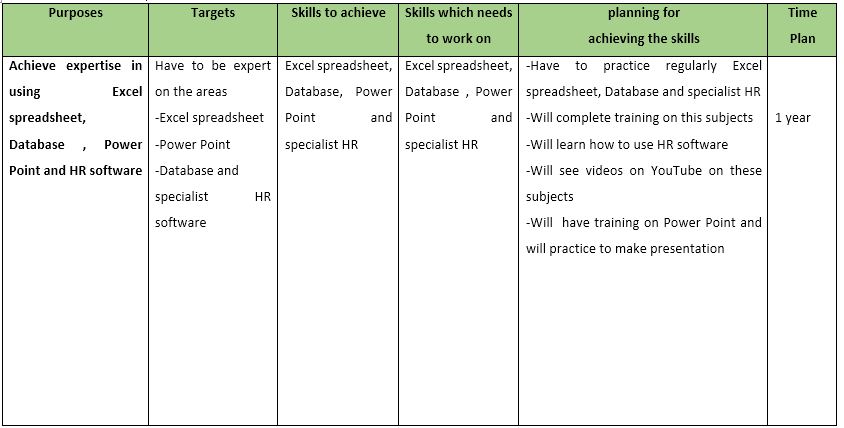
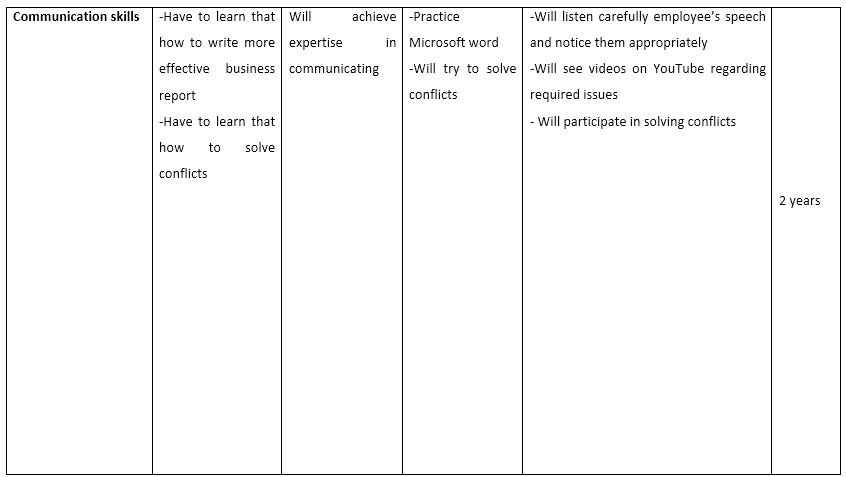
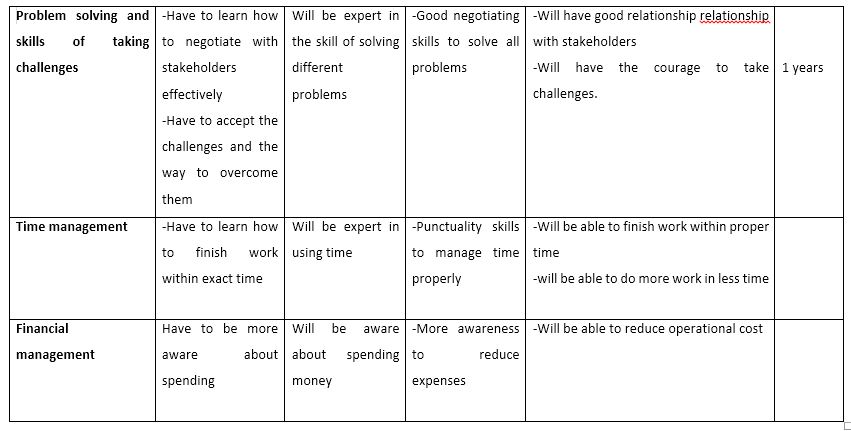
Conclusion:
The business world is getting more modernized and becoming too much competition. Organizations should have a competitive advantage to stay more powerful than their competitors. The development of technology has made business more complicated and competitors are also growing fast in every sector. Organizations should have eligible HR professionals who have the expertise of communication skills, technology using skills and taking challenges, all these will help an organization to exist in the competitive business world.
List of references
Akhtar, S., Ding, D.Z. and Ge, G.L., 2008. Strategic HRM practices and their impact on company performance in Chinese enterprises. Human Resource Management: Published in Cooperation with the School of Business Administration, The University of Michigan and in alliance with the Society of Human Resources Management, 47(1), pp.15-32.
Brushett, F.R., Thorum, M.S., Lioutas, N.S., Naughton, M.S., Tornow, C., Jhong, H.R.M., Gewirth, A.A. and Kenis, P.J., 2010. A carbon-supported copper complex of 3, 5-diamino-1, 2, 4-triazole as a cathode catalyst for alkaline fuel cell applications. Journal of the American Chemical Society, 132(35), pp.12185-12187.
Devece, C., Palacios-Marqués, D. and Alguacil, M.P., 2016. Organizational commitment and its effects on organizational citizenship behavior in a high-unemployment environment. Journal of Business Research, 69(5), pp.1857-1861.
Erbes, J., Nezhad, H.R.M. and Graupner, S., 2012. The future of enterprise IT in the cloud. Computer, 45(5), pp.66-72.
Georgopoulos, A.P., Tan, H.M., Lewis, S.M., Leuthold, A.C., Winskowski, A.M., Lynch, J.K. and Engdahl, B., 2010. The synchronous neural interactions test as a functional neuromarker for post-traumatic stress disorder (PTSD): a robust classification method based on the bootstrap. Journal of neural engineering, 7(1), p.016011.
Jhong, H.R.M., Brushett, F.R. and Kenis, P.J., 2013. The effects of catalyst layer deposition methodology on electrode performance. Advanced Energy Materials, 3(5), pp.589-599.
Masoudi, A., Hosseini, H.R.M., Shokrgozar, M.A., Ahmadi, R. and Oghabian, M.A., 2012. The effect of poly (ethylene glycol) coating on colloidal stability of superparamagnetic iron oxide nanoparticles as potential MRI contrast agent. International journal of pharmaceutics, 433(1-2), pp.129-141.
